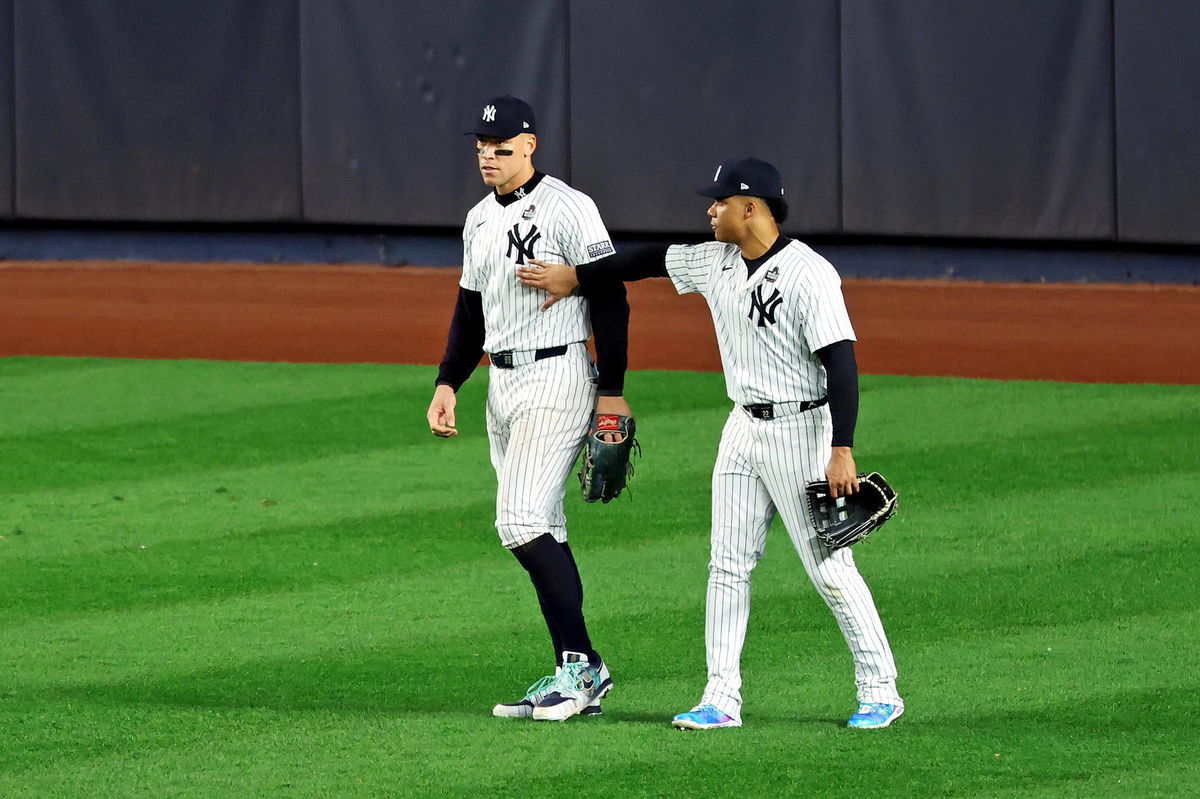
Imago
MLB, Baseball Herren, USA World Series-Los Angeles Dodgers at New York Yankees Oct 30, 2024 Bronx, New York, USA New York Yankees outfielder Juan Soto 22 reacts with outfielder Aaron Judge 99 after Judge dropped a fly ball during the fifth inning against the Los Angeles Dodgers during game five of the 2024 MLB World Series at Yankee Stadium. Bronx Yankee Stadium New York USA, EDITORIAL USE ONLY PUBLICATIONxINxGERxSUIxAUTxONLY Copyright: xJamesxLangx 20241030_pjc_sj8_513

Imago
MLB, Baseball Herren, USA World Series-Los Angeles Dodgers at New York Yankees Oct 30, 2024 Bronx, New York, USA New York Yankees outfielder Juan Soto 22 reacts with outfielder Aaron Judge 99 after Judge dropped a fly ball during the fifth inning against the Los Angeles Dodgers during game five of the 2024 MLB World Series at Yankee Stadium. Bronx Yankee Stadium New York USA, EDITORIAL USE ONLY PUBLICATIONxINxGERxSUIxAUTxONLY Copyright: xJamesxLangx 20241030_pjc_sj8_513
ADVERTISEMENT
During the Washington Nationals’ game against the Los Angeles Angels on June 29, the Angels repeatedly pointed to first base, walking the Nationals’ young left fielder four times, and echoes of Bonds’ era filled the ballpark. Not since 2004 had a player been intentionally walked so often in a single game. Meanwhile, in the Bronx, Aaron Judge continued to draw the kind of attention reserved for legends. With his 23rd intentional walk of the season, matching
Mickey Mantle’s 1957 Yankees record, and joined Albert Pujols as the only player to reach that mark before the All-Star break.Intentional walks were once a drawn-out ritual, with four wide pitches to signal surrender. In 2017, however, MLB streamlined the process: now, a manager flashes four fingers and the batter takes first. On paper, it’s saved time, but in practice, it’s deprived fans of watching their favorite hitters swing in the biggest moments. “I want to get rid of the intentional walk,” Jomboy Media co-creator and analyst Jake Storiale told Trevor Plouffe: “What if there was a rule that if you threw four straight balls, you got a runner on first, and the batter could stay if they wanted?… So if the pitcher throws four non-competitive pitches, the batter can choose if they could stay up.”
MLB should introduce a new rule for intentional walks pic.twitter.com/avKxGY5Hh5
— Talkin’ Baseball (@TalkinBaseball_) July 3, 2025
A rule allowing hitters to challenge or override intentional walks could revolutionize MLB’s offensive strategy. Judge, for example, is often walked when there are high-stakes situations, something fans pay to see. For rising talents like Wood, who intentionally walked four times in one game, his exposure is limited. “That stinks,” Storiale stated bluntly: “I want to see James hit.”
It’s true, and the Nationals outfielder and the Yankees captain aren’t the only examples. Mariners’ Cal Raleigh, known for late-game power, often sees the bat taken out of his hands due to matchup-based evasion. Challenging walks would also give young sluggers more at-bats under pressure, critical for growth and fan connection.
How new rules affect the game
Before 2017, intentional walks at least came with a sliver of unpredictability. Pitchers were still expected to deliver four live balls, leaving room for wild pitches, stolen bases, or even ambush swings. The shift to an automatic walk was intended to speed up games. However, it has also eliminated one of the few remaining chances to disrupt an otherwise heavily controlled situation. One of baseball’s dramatic tipping points is now reduced to a formality. It also deprives fans of a confrontation that might have tilted the inning.
As MLB shifts toward faster, intentional walks now feel like an outdated workaround. They represent managerial conservatism in an era increasingly defined by action. In a league where highlights drive engagement, pitch-around strategies often rob broadcasts of what should be the most compelling camera moments. After all, it’s a star hitter staring down a game on the line.
Challenging walks would also give young sluggers more at-bats under pressure, critical for growth and fan connection. Avoidance-based pitching and more accountability from pitchers facing emerging threats could also become a common occurrence.
Overall, allowing hitters to contest intentional walks could make MLB more dynamic, developmental, and marketable. It may also boost offensive action while keeping star players in the spotlight. However, any real change would be up to the playing rules committee. While automatic IBBs passed easily in 2016, the committee’s openness to small adjustments could suggest further iterations on the table, especially if there’s interest in re-introducing competitive dynamics to the game.
ADVERTISEMENT
ADVERTISEMENT
ADVERTISEMENT
ADVERTISEMENT

